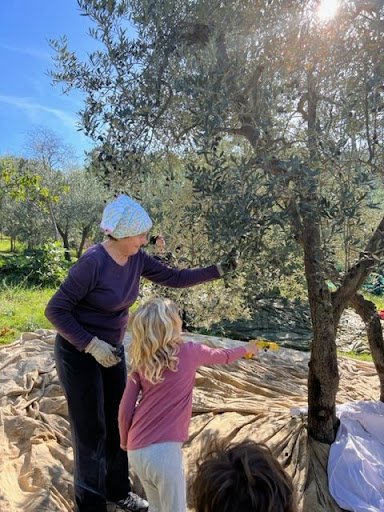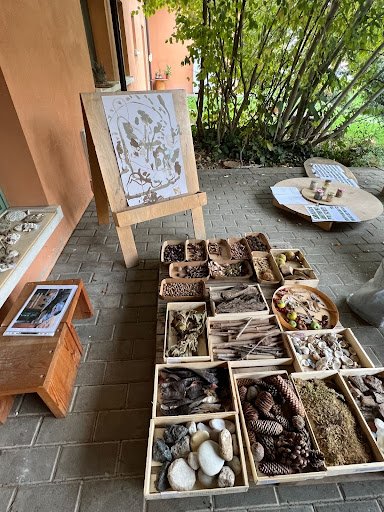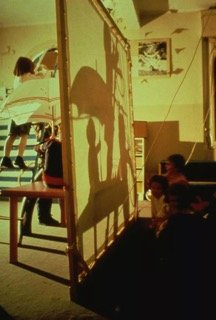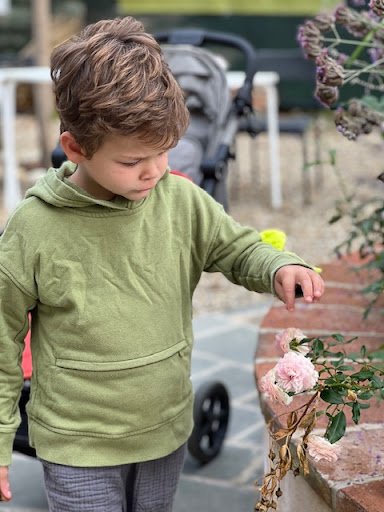By Sarah DeLuca
“Your image of the child: Where teaching begins”
— Loris Malaguzzi, 1994, p. 52
My daughter, Sicilia, invited by neighbors to harvest olives
“Amooooore,” (“Looooove,”) an Italian mother crooned over her child, looking at her with adoring eyes (note: this is a scene you might witness in any city, piazza, cafe, park in Italy). Every time I hear someone call their child “amore,” I can’t help but smile at the adoration Italians have for children. My husband and I have witnessed this first hand since our daughter was a baby and when we traveled through Italy with her. We felt like the red carpet was rolled out for us because we had a child. “This is NOT the experience we have had in the U.S.!” we thought, especially in airports, grocery stores, or anywhere with a line, whereas in Italy, families with young children have priority and precedence. For years I’ve wondered about the reasoning behind this wonderful cultural perspective, which I have learned can be attributed to many factors: a low birth rate (making children in Italy more rare and precious), a culture strongly tied to family and community, and one that celebrates the beauty in everything (and that takes the time to savor such things). Among them are family, food, art, architecture, and other cultural phenomena born out of the beautiful interaction between humans and the natural world.
A municipal building in Reggio Emilia at dawn
Since beginning my studies into the Reggio Emilia approach through graduate coursework, literature on the Reggio Emilia philosophy, and, recently, a weeklong visit to the city of Reggio Emilia, I keep learning about the concept of “the image of the child” as a core foundational piece in understanding the approach. This idea directly correlates to the strong cultural association of Italians and the culture of childhood, which, as I describe above, they seem to naturally value as a society. This feels especially true in the city of Reggio Emila itself. Loris Malaguzzi, founder of the Reggio Emilia approach explains, “our image of the child is rich in potential, strong, powerful, competent, and most of all, connected to adults and other children” (Malguzzi, 1993, p. 10). The Reggio and Reggio inspired educators assert that we must believe that children are capable of constructing their own understanding of the world. They respect their competency, agency, and allow them to follow their interests in their learning; the emphasis is on the importance of trusting children. In this blog post I examine how the strong image of the child is a societal construct, and how it supports the Reggio Emilia approach. I also share examples of what I learned while in the city of Reggio Emilia to illustrate the rich, complex, and competent image of the child that Italian educators uphold.
The Image Of The Child As A Societal Construct
Community Dancing in the piazza in Reggio Emilia
The city of Reggio Emilia has always had a strong social-political community, championing women's rights to work, and children’s rights to a quality early childhood education. When one visits the city, it is evident and clear that these values are an integral part of the community and that everyone is responsible for perpetuating these rights. On the Sunday I arrived in Reggio Emilia, it seemed the entire community was in the streets: families strolling down the sidewalk, pausing to shop or eat lunch, young couples on park benches, old and young chatting at the cafe, playing in the park, people practicing community dances in the piazza at night; you could tangibly feel a sense of community.
It’s not a surprise that decisions that benefit children in the city are made by the community members as they are invited to be a part of the childhood city council, a decision making board for the early childhood infant toddler centers and preschools of Reggio Emilia. During their presentation “The Image of the Child,” Italian educators Alessandra Braglia and Valentina Violi described childhood as,
…a social construct, an interpretation…Every society and culture has their own image of the child. It affects our relationship with our children, as well as our educational choices of learning and school. In Reggio we welcome children with special rights. We have to make our image of the child explicit to recognize the potential of all children and to recognize the contact in which they live and create experiences.” (Reggio Children Study Tour, 2022).
Each society and person’s constructs of this image are subjective, personal, and tied to culture and beliefs. As educators, it is integral that we examine and reflect upon a shared understanding and vision of how we view children.
An Inclusive, Strengths Based Image Of The Child
The beautiful, intentional materials children have a right to explore
Reggio Emilia educator Carlina Rinaldi describes further the societal constructs of the image of the child, and how in Reggio Emilia, the focus is a strengths based approach,
Childhood is created by each society . . . The image is a cultural convention, and there are many possible images. Some focus on what children are, what they have, and what they can do, while others, unfortunately, focus on what children are not, do not have, and what they are not able to do.” (1993, p. 50)
An amazing example of focusing on children’s rights and what they can do, is the language used for children who in the United States would be deemed as “special needs” children. In the Reggio Emilia schools, they are called children with special rights, and priority into the infant toddler centers and preschools is given to these children. In fact, the term “rights” holds a special connotation in Reggio, and the organization Reggio Children has an entire charter on “Children’s Rights,” which can be found here. Language is so meaningful and this shift in language, and perspective, directly reflects their values of inclusivity, social justice, the rights for all children to a quality education, all the while perpetuating and reinforcing the idea of a strengths-based image of the child. Students are defined as “powerful, active, competent protagonists of their own growth . . . and call on adults nearby to serve as partners, resources, and guides.” (Edwards, 1993, p.150).
Atelierista Vea Vecchi carrying out research with children at the Diana Preschool in Reggio Emilia
Another beautiful example of upholding an image of a competent child was portrayed through a video shown in my recent study tour in Reggio Emilia. In the video, a teacher in a preschool classroom worked with two children: Tommaso, a child with special rights (specifically downs syndrome) and another child, Simone, (a child who does not have special rights). In the video, the children are engaged in a research topic of the relationship of graphic language and narrative. The teacher has intentionally gathered different materials for graphic mark-making on paper (various sizes and colors of papers, black, white, and a variety of colors of markers) and invites the children to sit down and begin drawing. Simone begins drawing circles on white paper, and Tomasso excitedly gathers all the markers together, gathering them up in his hands and mixing them together joyfully. The teacher shows him the colors and invites him to choose one. He begins making marks on paper, not choosing to represent something specific, and glances at his friend Simone, who is describing his marks, “This is me, this is my mama.” In the video, the teacher skillfully helps the children explain their drawing, interact with each other, and switches out different materials to create different possibilities and ways of expression (handing Tommaso the black paper and white pen as a new experience for mark making). She plays along when he excitedly pretends the markers are birthday candles, they sing happy birthday to each child, and Simone, picking up on Tomasso’s birthday play, begins to draw a cake. The video was a short 5 minutes, but there are so many incredible learning moments: the teacher is facilitating communicating and building relationships, she shares in the children’s delight and joy, she knows when to step back and let the children interact, modeled respect, listened with intention, all the while modeling her clear beliefs that these children are capable, competent, and deserve the right to a quality education.
How Documentation Can Help Support A Strong Image Of The Child
A Documentation Panel from the Paulo Freire Preschool in Reggio Emilia
Also in my recent Reggio Emilia study tour, Violi and Braglia described how teachers view children: “We have to consider the whole child, not a fragmented approach. A child is a person that is able to construct their own learning - they pose questions, always seeking something new. They form hypotheses and theories, they are natural researchers, seekers for the sense of life.” The two presenters go on to describe the role of teachers as co-researchers with the children on a collective search for meaning. This is foundational and an important piece of teaching in this approach. “Research is the foundation of our educational thinking. Research gives deep meaning to everyday activities. It’s a daily tension to consider theory and practice at the same level. We strive for a deep connection between the two.” Not only are the teachers encouraging this act of research with children, but they themselves are constructing research on how and what the children are doing, documenting the children’s learning on a daily basis.
The Reggio educators document children’s learning in a myriad of ways: taking notes on what children are doing, writing down transcripts of their conversations, taking photographs of children working, of their process, taking videos, etc. Violi and Braglia shared, “The teacher builds their knowledge by learning more about children’s learning processes. The teachers reflect with colleagues and have an exchange of ideas . . . to look for new possibilities, and set up stronger contexts (for learning).” In this way, teachers are truly co-authors of the learning processes with children. The teachers then use this extensive documentation together, as a team, to review possible next steps in the learning process, to bring it back to children and ask them questions about their thinking, processes, and research, and to project a strong and competent image of the child. Documentation panels, which are a combination of photos of children’s processes, work, quotes on their thinking and descriptions, anecdotal observations from teachers, transcripts of children’s thinking and dialogue, (and more), are one way in which the learning and research is shared and the image of the child perpetuated.
George Forman and Brenda Fyfe, contributing authors to The Hundred Languages of Children, make a direct correlation to documentation and perpetuating a strong image of the child: “Documentation can make visible the work of the schools and the capacities of children. Real examples of documented learning offer the public a more particular kind of knowledge that empowers and provokes them to reflect, question, and rethink or reconstruct the image of the child and the rights of children to quality education” (1993, p. 267). In Reggio Emilia, large documentation panels cover walls to the infant toddler centers and preschools and the Loris Malaguzzi International Center, places one might expect to find them. What surprised and impressed me was also finding traces of the documentation panels in other areas around the city (such as the ReMida recycling center). I wonder what areas of the city are intentionally displaying children’s thoughts, learning processes, and research, and how that helps to convey a strong image of the child. Where in our own communities do we publicly display and share artwork and our vision of children? What other intentional ways we can document children’s learning to help encourage our collective view of children?
In their book, Seeing Young Children With New Eyes, authors Sydney Gurewitz Clemens and Leslie Gleim describe the link between documentation and the image of the child, “We can’t really separate the subject of the documentation process from that of changing our Image of the Child. To manage the latter, we must practice the former.” Throughout the book, Gleim (a Hawaiʻi based Reggio Emilia inspired educator at Mid Pacific Institue’s Preschool), describes the power of documenting the children in her special rights classroom while teaching in Ohio, and gives beautiful, concrete examples of how documentation helps to strengthen the image of several of her students in the eyes of themselves, other teachers, and their families, through her unwavering belief in each child as competent, capable, and worthy of a quality education. She describes the benefit of documenting children closely, “If done well, documentation enters and changes the lives of the children, the families, and the understanding of the teacher. This work vitally impacts the hearts and lives of the children, the families and the teacher, provoking further growth for all” (Clemens, 2012, p. 81)!
Un Sacco di Respect: A Ton of Respect
Children in Reggio Emilia, trusted to explore and make meaning of their world
Another fortunate part of my visit to Reggio in October, was a visit to two schools: a combined infant toddler center/preschool, and a preschool. I observed parents highly involved in their child’s education in Reggio Emilia. They have many opportunities to dialogue with teachers about their children, get involved in the projects of study, and are also invited to be a part of the childhood municipal council, making decisions on behalf of the schools; It is no wonder that parents were invited to offer their perspectives to the study group participants. At the first infant toddler center/preschool, I spoke to a parent whose son had attended the school since he was an infant, and is now five years old. I asked her what stood out to her as a parent, and what her experience has been like the past four years at the school. She told me about some of the special aspects of the school, included a dedicated kitchen and cook for children to explore the languages of food, the high quality materials and freedom to explore them, but what stood out most to me (and seemingly to her as well), was when she explained the teachers as having “un sacco di respect” which translates to “a ton of respect” for the children. The emotion she conveyed speaking about her feelings for the school as an incredible place for her son was palpable; I left feeling that “sacco di respect” on so many levels.
Conclusion: Personal Tie-Ins
The image of the child as a fundamental idea upon “which society is based,” as author Carlina Rinaldi states, is a crucial concept in Reggio thinking and thought. This concept has continued with me throughout each day as I think about my own children (what is the image I have of them, the image society has of them, the image their school has of them), and how does that shape every interaction, our trust, and our belief in them and their competency? As a mother, does this mean I stand back and let them learn most things for themselves, does it mean pausing to listen and give my full attention more, following their interest and leads? As an early childhood educator, it means much of the same, but adding on layers of social interactions, and the various cultural differences and experiences each child brings to the class each day.
My son, Enzo, exploring his world through his senses
As I construct my own understanding of what this Reggio approach entails, I continue to reflect on how to support a strong image of my own children as well as the children I teach. I wonder about the Reggio approach and how much of the major foundational pieces, like the strong communal image of the child, is deeply rooted in Italian culture. I think about a recent trip to a cafe with my family: My son Enzo, five years old, uncapped a large water bottle and poured it into a glass cup. This is a simple yet somewhat challenging motor experience for him. I held myself back, unsure if he would spill. He didn't (I told myself to encourage the strong image of the child!) and the elderly Italian owner of the cafe stood watching Enzo pour the water. He paused from across the cafe, smiled and gave a subtle clap when he had poured the water independently. It was such a simple and short experience, but it helped me bridge connections with my Reggio learning thus far, and it was a great learning moment for me as a parent. It was also fascinating that this owner took the time to observe this exchange and appreciate his independence. These little moments happen here and there, and I wonder, am I just paying attention to them more now that I’m immersed in this Reggio inspired learning?
George Forman and Brenda Fyfe, in the book The Hundred Languages of Children, describe the importance of truly listening to children as a way of upholding this strong image:
Teachers who embrace the pedagogy of listening have an image of the child whose ideas are worth listening to, whose comments and opinions are not just frivolous and cute but instead intelligent efforts to make sense of the world . . . The more teachers develop reciprocal expectations of the pedagogy of listening, the stronger the image of the child grows–in the minds of teachers, children, and parents (1993, p. 286)
What happens when we pause to truly listen to our children?
For example, again with my son (along with my daughter, one of my greatest teachers) who, on the drive to school recently, through the forest one foggy, mystical morning, asked, “Can you taste fog?” My husband began to answer him right away (which as parents, is a natural response, to help provide answers), but I stopped him, thinking instead of where this inquiry and learning might go. I wanted to know more about his thinking. We rolled down the windows so he could experience the fog more, and to see if we could all use our senses to feel or “taste” it, as he had suggested. He commented that it didn't taste like anything, and he was curious if it tasted like cotton candy because his sister had mentioned once that clouds look (and might taste) like cotton candy. He was bridging relationships between previous learning (from his sister), asking questions about his environment, and using his senses to construct his own understanding of his world. This experience had me reflecting on so many different aspects of my learning, particularly in an educational setting, where a strong image of the child would encourage this exploration on a deeper level. What a beautiful question, rich with possibility! What image of the child would we be portraying if we had not taken the time to listen, and answered his question directly? What image of the child would we have conveyed if we did not allow Enzo to construct his own understanding of weather and fog, and what that means to him?
The Reggio Educators I encountered on this recent study tour shared that when we take the time to nurture this strong image of the child we nurture their deep search for making meaning of the world around them. As I reflect on this, it seems we are all on this search for making meaning. As educators we have the privilege of co-constructing meaning making with children. Therefore, it is our work to use the capable, competent and beautiful image we have of children to create environments and situations where they feel “un sacco di respect” for their questions, ideas, and understanding of the world, and where they know and understand our strong image of them; it is their right and our responsibility.
Works Cited:
Alessandra Braglia and Valentina Violi The Image of the Child Presentation, Reggio Emilia Study Tour. Loris Malaguzzi International Center. 2022.
Clemens, Sydney Gurewitz and Gleim, Leslie. Seeing Young Children with New Eyes: What We’ve Learned From Reggio Emilia About Children and Ourselves. Self-Published, Leslie Gleim, 2012.
Edwards, C. (1993) Teacher and Learner, Partner and Guide. Gandini, Lella, Edwards, Carolyn P. and Forman, George. The Hundred Languages of Children : the Reggio Emilia Experience in Transformation. Norwood, N.J. :Ablex Pub. Corp.
Forman, G., Fyfe, B. (1993) Negotiated Learning. Gandini, Lella, Edwards, Carolyn P. and Forman, George. The Hundred Languages of Children : the Reggio Emilia Experience in Transformation. Norwood, N.J. :Ablex Pub. Corp.
Malaguzzi, L. (1993) An Interview With Loris Malaguzzi. Gandini, Lella, Edwards, Carolyn P. and Forman, George. The Hundred Languages of Children : the Reggio Emilia Experience in Transformation. Norwood, N.J. :Ablex Pub. Corp.
Malaguzzi, L. (1994). Your image of the child: Where teaching begins. Child Care Information Exchange, 3, 52–61.
Rinaldi, C. (2001) Reggio Emilia: The Image of the Child and the Child’s Environment As a Fundamental Principle. Gandini, L. Edwards, Carolyn P. Bambini : The Italian Approach to Infant/Toddler Care. New York: Teachers College Press.
ABOUT THE AUTHOR:
Sarah DeLuca is a K-1 early childhood educator at Hanahauʻoli School, where she has been teaching and learning with and from her students, colleagues, and families since 2009. Sarah was born and raised in the Kaimuki area and is an alumnus of Iolani School. She received her bachelor's degree from the University of Oregon in International Studies and her (MEdT) at the University of Hawaii at Manoa. She has lived and studied in Italy and enjoys traveling to spend time with extended family there. She finds great joy in working alongside young children, particularly exploring our beautiful island home, creating art, and getting lost in the wonderful world of books.












